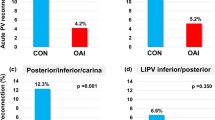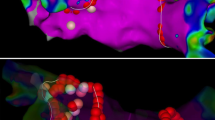Abstract
Purpose
Early recurrence of atrial tachyarrhythmias (ERAT) cause various symptoms and predict worse outcomes after pulmonary vein isolation (PVI). This study aimed to clarify whether ablation index (AI)–guided PVI, which is a novel technology of radiofrequency ablation, could reduce ERAT as compared to conventional contact force (CF)–guided PVI.
Methods
Consecutive atrial fibrillation (AF) patients who underwent initial PVI from September 2014 to August 2019 were enrolled. We divided the patients into two groups: patients who underwent AI-guided PVI (AI group) and those who underwent CF-guided PVI (CF group). Using propensity score matching (PSM), we adjusted for the patient backgrounds. We compared the incidence of ERAT and late reconnection rate of isolated pulmonary veins (PVs) during second session between the two groups. ERAT was defined as any atrial tachyarrhythmias ≥ 30 s during a 90-day blanking period.
Results
A total of 697 AF patients (paroxysmal 51%) were enrolled. After the PSM, both groups included 229 patients. The incidence of ERAT was significantly lower in the AI group than that in the CF group (21.5% vs. 36.1%, P < 0.001). Total 118 patients (25.7%) experienced late recurrence of atrial tachyarrhythmias (LRAT) after blanking period. LRAT free survival rate was significantly higher in patients without ERAT than those with ERAT (88.1% vs. 42.0%, P < 0.001). The rate of PV reconnection was lower in the AI group than that in the CF group (45.8% vs. 71.4%, P = 0.028). Multivariate analysis demonstrated that AI-guided PVI was independently correlated with ERAT (OR = 0.415, 95%CI = 0.269–0.639, P < 0.001).
Conclusions
AI-guided PVI can reduce ERAT as compared to conventional CF-guided PVI.





Similar content being viewed by others
Data availability
The data underlying this article will be shared on reasonable request to the corresponding author.
References
Kirchhof P, Benussi S, Kotecha D, Ahlsson A, Atar D, Casadei B, et al. 2016 ESC Guidelines for the management of atrial fibrillation developed in collaboration with EACTS. Eur Heart J. 2016;37(38):2893–962. https://doi.org/10.1093/eurheartj/ehw210.
Calkins H, Hindricks G, Cappato R, Kim YH, Saad EB, Aguinaga L, et al. 2017 HRS/EHRA/ECAS/APHRS/SOLAECE expert consensus statement on catheter and surgical ablation of atrial fibrillation. Heart Rhythm. 2017;14(10):e275–444. https://doi.org/10.1016/j.hrthm.2017.05.012.
Themistoclakis S, China P. Early recurrences of atrial tachyarrhythmias after ablation of atrial fibrillation: how long do we have to be blind? JACC Clin Electrophysiol. 2017;3(6):577–9. https://doi.org/10.1016/j.jacep.2017.03.012.
O’Donnell D, Furniss SS, Dunuwille A, Bourke JP. Delayed cure despite early recurrence after pulmonary vein isolation for atrial fibrillation. Am J Cardiol. 2003;91(1):83–5. https://doi.org/10.1016/s0002-9149(02)03005-9.
Das M, Wynn GJ, Morgan M, Lodge B, Waktare JE, Todd DM, et al. Recurrence of atrial tachyarrhythmia during the second month of the blanking period is associated with more extensive pulmonary vein reconnection at repeat electrophysiology study. Circ Arrhythm Electrophysiol. 2015;8(4):846–52. https://doi.org/10.1161/CIRCEP.115.003095.
Andrade JG, Khairy P, Verma A, Guerra PG, Dubuc M, Rivard L, et al. Early recurrence of atrial tachyarrhythmias following radiofrequency catheter ablation of atrial fibrillation. Pacing Clin Electrophysiol. 2012;35(1):106–16. https://doi.org/10.1111/j.1540-8159.2011.03256.x.
Das M, Loveday JJ, Wynn GJ, Gomes S, Saeed Y, Bonnett LJ, et al. Ablation index, a novel marker of ablation lesion quality: prediction of pulmonary vein reconnection at repeat electrophysiology study and regional differences in target values. Europace. 2017;19(5):775–83. https://doi.org/10.1093/europace/euw105.
Hussein A, Das M, Chaturvedi V, Asfour IK, Daryanani N, Morgan M, et al. Prospective use of Ablation Index targets improves clinical outcomes following ablation for atrial fibrillation. J Cardiovasc Electrophysiol. 2017;28(9):1037–47. https://doi.org/10.1111/jce.13281.
Nakagawa H, Ikeda A, Govari A, Papaioannou T, Constantine G, Bar-Tal M, et al. Abstract 12104: Prospective study using a new formula incorporating contact force, radiofrequency power and application time (Force-Power-Time Index) for quantifying lesion formation to guide long continuous atrial lesions in the beating canine heart. Circulation. 2013;128(suppl_22):A12104–A12104. https://doi.org/10.1161/circ.128.suppl_22.A12104.
Pranata R, Vania R, Huang I. Ablation-index guided versus conventional contact-force guided ablation in pulmonary vein isolation-systematic review and meta-analysis. Indian Pacing Electrophysiol J. 2019;19(4):155–60. https://doi.org/10.1016/j.ipej.2019.05.001.
Ullah W, Hunter RJ, Finlay MC, McLean A, Dhinoja MB, Sporton S, et al. Ablation index and surround flow catheter irrigation: impedance-based appraisal in clinical ablation. JACC Clin Electrophysiol. 2017;3(10):1080–8. https://doi.org/10.1016/j.jacep.2017.03.011.
Hussein A, Das M, Riva S, Morgan M, Ronayne C, Sahni A, et al. Use of ablation index-guided ablation results in high rates of durable pulmonary vein isolation and freedom from arrhythmia in persistent atrial fibrillation patients: the PRAISE study Results. Circ Arrhythm Electrophysiol. 2018;11(9):e006576. https://doi.org/10.1161/circep.118.006576.
Kuck KH, Brugada J, Fürnkranz A, Metzner A, Ouyang F, Chun KR, et al. Cryoballoon or radiofrequency ablation for paroxysmal atrial fibrillation. N Engl J Med. 2016;374(23):2235–45. https://doi.org/10.1056/NEJMoa1602014.
Dukkipati SR, Cuoco F, Kutinsky I, Aryana A, Bahnson TD, Lakkireddy D, et al. Pulmonary vein isolation using the visually guided laser balloon: a prospective, multicenter, and randomized comparison to standard radiofrequency ablation. J Am Coll Cardiol. 2015;66(12):1350–60. https://doi.org/10.1016/j.jacc.2015.07.036.
Tokuda M, Yamashita S, Matsuo S, Kato M, Sato H, Oseto H, et al. Clinical significance of early recurrence of atrial fibrillation after cryoballoon vs. radiofrequency ablation-a propensity score matched analysis. PLoS One. 2019;14(7):e0219269. https://doi.org/10.1371/journal.pone.0219269.
Verma A, Jiang CY, Betts TR, Chen J, Deisenhofer I, Mantovan R, et al. Approaches to catheter ablation for persistent atrial fibrillation. N Engl J Med. 2015;372(19):1812–22. https://doi.org/10.1056/NEJMoa1408288.
Ho SY, Sanchez-Quintana D, Cabrera JA, Anderson RH. Anatomy of the left atrium: implications for radiofrequency ablation of atrial fibrillation. J Cardiovasc Electrophysiol. 1999;10(11):1525–33. https://doi.org/10.1111/j.1540-8167.1999.tb00211.x.
Themistoclakis S, Schweikert RA, Saliba WI, Bonso A, Rossillo A, Bader G, et al. Clinical predictors and relationship between early and late atrial tachyarrhythmias after pulmonary vein antrum isolation. Heart Rhythm. 2008;5(5):679–85. https://doi.org/10.1016/j.hrthm.2008.01.031.
Sugumar H, Nanayakkara S, Chieng D, Wong GR, Parameswaran R, Anderson RD, et al. Arrhythmia recurrence is more common in females undergoing multiple catheter ablation procedures for persistent atrial fibrillation: time to close the gender gap. Heart Rhythm. 2019. https://doi.org/10.1016/j.hrthm.2019.12.013.
Schreiber D, Rostock T, Frohlich M, Sultan A, Servatius H, Hoffmann BA, et al. Five-year follow-up after catheter ablation of persistent atrial fibrillation using the stepwise approach and prognostic factors for success. Circ Arrhythm Electrophysiol. 2015;8(2):308–17. https://doi.org/10.1161/circep.114.001672.
Liang JJ, Elafros MA, Chik WW, Santangeli P, Zado ES, Frankel DS, et al. Early recurrence of atrial arrhythmias following pulmonary vein antral isolation: timing and frequency of early recurrences predicts long-term ablation success. Heart Rhythm. 2015;12(12):2461–8. https://doi.org/10.1016/j.hrthm.2015.07.015.
Pranata R, Vania R, Huang I. Ablation-index guided versus conventional contact-force guided ablation in pulmonary vein isolation-systematic review and meta-analysis. Indian Pacing Electrophysiol J. 2019;19(4):155–60. https://doi.org/10.1016/j.ipej.2019.05.001.
Acknowledgements
We thank the clinical engineers in Osaka Rosai Hospital for their technical assistance during the electrophysiological study and John Martin for his linguistic assistance.
Author information
Authors and Affiliations
Corresponding author
Ethics declarations
Ethics approval
This study was approved by the local ethics committee (approved number: 2020–29).
Informed consent
All patients provided their informed consent for the CA procedure.
Conflict of interest
The authors declare no competing interests.
Additional information
Publisher's note
Springer Nature remains neutral with regard to jurisdictional claims in published maps and institutional affiliations.
Rights and permissions
About this article
Cite this article
Yasumoto, K., Egami, Y., Ukita, K. et al. Ablation index–guided pulmonary vein isolation can reduce early recurrences of atrial tachyarrhythmias: a propensity score–matched analysis. J Interv Card Electrophysiol 64, 479–487 (2022). https://doi.org/10.1007/s10840-021-01059-y
Received:
Accepted:
Published:
Issue Date:
DOI: https://doi.org/10.1007/s10840-021-01059-y




